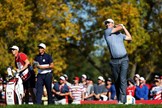VIDEO: How to play the shots that won the Ryder Cup at Hazeltine
Last updated:
Hazeltine head pro Chandler Withington reveals how you can play three of the shots which were pivotal in this year’s Ryder Cup.
The shot: 17th tee shot
None of the 24 Ryder Cup players hit their irons dead straight.
They all have a stock shape, but adapt to suit the task in front of them.
The choice at 17 was a fade held against the wind, or more of a punch with a bit of draw?
When choosing the best shape, the biggest call you need to make is where you can and can’t miss the green.
In matchplay, the biggest enemy is water; find it and it usually results in loss of hole. Once you’ve established this, you also need to take into account where the wind is coming from and what ball flight you would play to give you the biggest room for error.
With the water right most players looked to play a bit more of a low draw, starting it off the tree on the right side of the green.
A few watched their shots draw too much over the weekend but missing to the left of the green is still dry and a fade could have got away from the player and ended up in a hazard.
How to play it
1. Close the face, then grip
For a draw I close the club slightly and re-take my grip with the club in front of me. I’ll make my normal swing because the shut face gives me my ball flight. If I keep my swing on plane the same way as normal it should impact that way.
2. Body right, face square
Feet, hips and shoulders should be aimed right of the target for the right-hander, with the face at the target. To hit a harder draw, turn the club more through your hands so you need to aim further right to keep the face aimed at the target.
3. Heat of battle
Any match reaching the 17th will be tight, and players will choose their shape according to the match status. In the lead you can afford a safer shape; if you’re behind you need the shape that takes on the pin.
The Shot: 15th approach shot
The best shots hit off the tee on 15 over the weekend were right-to-left tee shots which ran leaving about 80 yards in with most players then following up with a low scudding pitch shot to access a rear pin.
The key for players here was controlling trajectory which is all about controlling your follow-through.
If your hands finish high, the shot will fly high. If they finish around your belt, the ball will fly a lot lower.
How to play it
1. Ball just back of centre
The ball is meant to be around centre at address but I’ll cheat a little and put it just back of centre so I can trap it a bit easier. It also takes a little loft off the club. The more you move the ball up, the more loft increases.
2. Take the hands out
To keep the ball low, play it like an extended chip shot. Feel your strike comes not from any hit with your hands and arms but from a simple pivot and rotation of the body. You’ll find this abbreviated finish that keeps loft off the face.
3. Use the big muscles
In pressure situations you don’t want to be using the small muscles, which are quicker to fire and twitch. Instead, look to pitch the ball with the chest and legs and just rotate through the shot.
The shot: 18th tee shot
The further and straighter you can hit it in matchplay, the more pressure you’ll put on your opponents, especially on the last hole of a Ryder Cup!
So distance and accuracy are key off the tee on 18 so good sequencing is needed in the swing to create a centred strike, key to long hitting.
1. Get the club moving first
Balance is key to good rhythm; find a position where you’d most resist being pushed over. The proper sequence starts from the ground upwards, so though the club has moved a long way my shoulders have not yet turned that much.
2. Retain shoulder turn
As you start down, use the strong leg muscles to shift weight. Do that without letting your shoulders to turn and you’ll pick up 20-30 yards instantly! The longer I can keep my shoulders turned away from the target, the more power I store.
3. Slow to fast
To build rhythm hit to the 150-yard markers with full driver swings. It’ll take a while to find the rhythm needed for solid strikes, but once you find it, go to 200 yards… and so on up to full speed.

